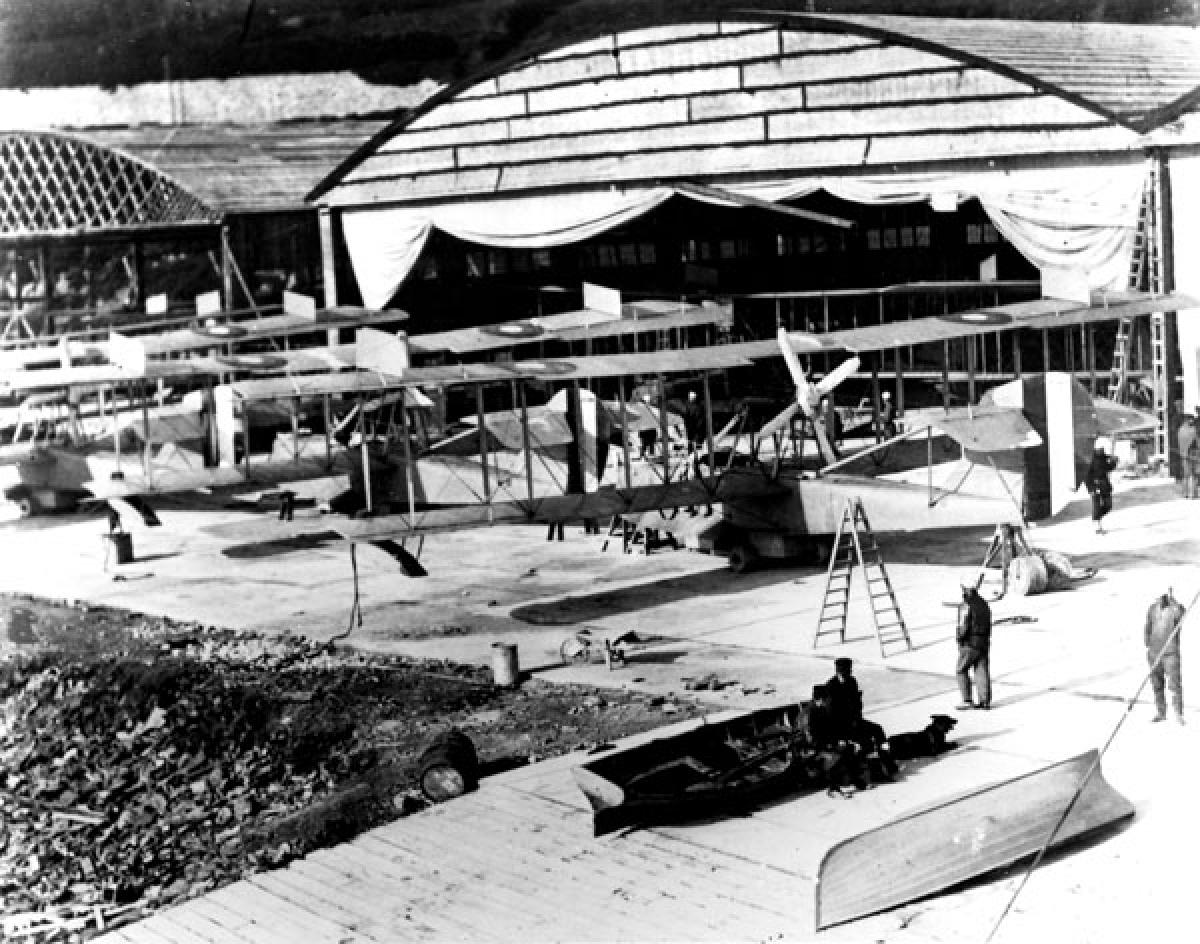The Great War Catalyst
Naval aviation’s early development occurred largely insulated from the cataclysmic events that swept across Europe in 1914. While a handful of naval personnel in the United States experimented with and evaluated the Navy’s small collection of flying machines, half a world away nations were building sizeable aerial armadas and the press of combat was triggering dramatic technological and tactical developments in air warfare. That changed when America entered World War I. The ensuing 19 months brought unimaginable expansion in U.S. naval aviation, providing a foundation for a more prominent postwar place in the Fleet.
Navy aviators claimed the distinction of being the first American combatants to land in France, when members of the First Aeronautic Detachment went ashore on 5 June 1917. But perhaps the most important naval aviation developments in World War I came far away from the front, with the building of the infrastructure to fight a world war. The Navy placed production contracts for aircraft on a scale never before seen and even established its own manufacturing plant, the Naval Aircraft Factory, to spur production by turning out designs of other manufacturers.
By war’s end the Navy’s aircraft inventory numbered 2,107 heavier-than-air types and 15 blimps; the outstanding designs included Curtiss flying boats, which would serve into the mid-1920s, and the DeHavilland DH-4, which flew raids over Belgium with the Northern Bombing Group. Those planes operated from scores of coastal air stations in France, Italy, and the British Isles, as well as locales such as North Island in San Diego Bay; Key West, Florida; and Hampton Roads, Virginia—stateside installations destined to play important roles in naval aviation for decades to come.
From a handful of personnel in 1911 grew a robust force that by 1918 numbered in the thousands, including mechanics, gunners, and some yeomanettes, the first women to serve in naval aviation. Once the almost exclusive domain of graduates of the U.S. Naval Academy, the ranks of aviators expanded during wartime to consist primarily of members of the Naval Reserve Flying Corps. Its core was a collection of Ivy Leaguers who even before America’s entry into the war formed the First Yale Unit and financed their own flight training in preparation for service in the U.S. Navy. Thus, hundreds got to experience Ensign Wayne Duffett’s feeling of taking to the skies: “About three days ago I had my first flight. . . . Where the big sensation comes is when you go ‘over the hump’ [start to descend]. All of a sudden you pitch down and the first thing you know you are once more gliding over the water. Oh, it is the greatest sensation you can imagine.” Duffett would successfully receive his coveted wings of gold and head overseas, joining others serving “Over There.”
Arriving on foreign shores, U.S. naval aviation personnel served alongside British, French, and Italian aviators experienced in the ways of air warfare after months of fighting over the Western and Italian fronts. Similarly, the aircraft they flew—Sopwiths, Spads, Nieuports, Capronis—were true combat types, in contrast to the training aircraft to which the early American naval aviators were accustomed back in the States. Foreign instructors trained the newly arrived Yanks, and in some cases the naval aviators were assigned to foreign squadrons. Among them was Lieutenant David S. Ingalls, Naval Aviator No. 85, who became the U.S. Navy’s only fighter ace of World War I while flying with a squadron of Britain’s Royal Air Force. Ensign Charles Hammann earned the Medal of Honor for rescuing a fellow aviator shot down by Austrian fighters, and did so flying an Italian seaplane fighter from Naval Air Station Porto Corsini, Italy.
U.S. Navy and Marine fliers constituted the front ranks of the Northern Bombing Group, which was organized by the Department of the Navy for the purpose of attacking German U-boat support facilities and other military installations in Belgium. The unit eventually boasted day and night wings. Smaller efforts led up to the bombing group’s first raid in force on 14 October 1918, against a German-held railroad junction. The war’s end came before plans to carry out an around-the-clock bombing campaign could be executed.
To be expected, given its early inventory of seaplanes, was U.S. naval aviation’s wide-ranging effort in antisubmarine warfare. The 43 air stations in operation by war’s end, more than three-quarters of them on foreign soil, were primarily devoted to seaplane operations. The daily routine of many naval aviators consisted of long-range patrols over wide expanses of ocean in search of U-boats. On 25 March 1918, Ensign John F. McNamara, flying out of Royal Naval Air Station Portland, England, became the first naval aviator to attack a German submarine while on patrol. He and his fellow airmen on both sides of the Atlantic logged some 3 million nautical miles in their war against the enemy’s undersea menace.
An important byproduct of front-line experiences was the opportunity afforded naval officers to witness the advancements of naval aviation in Europe. Two innovations in particular—the aircraft-carrying ships operated by the British and the long-range German Zeppelins that executed strategic bombing attacks on Great Britain—were to have a far-reaching impact on postwar operations in the U.S. Navy.




